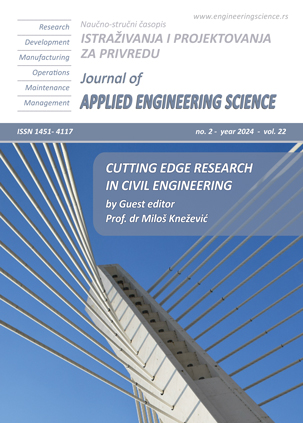ESTIMATING DAMAGE PROBABILITY OF THE PRESTRESSED SIMPLE BEAM THROUGH EIGENFREQUENCY MEASUREMENT
Abstract
The paper proposes a method for modal-based damage assessment in structures where historical data on their modal properties is often missing. This method is based on the measurements of the structure's eigenfrequencies and predefined assumed damage states. Damage is defined at the level of confirming damage existence with a rough estimate of its extent, within the limits of the predefined assumptions. The factors that affect the outcomes of experimental modal analysis of damaged reinforced and prestressed beam elements on structures in use are briefly outlined and the challenges encountered during these analyses and potential solutions are briefly discussed. The method's application is demonstrated on a damaged prestressed concrete simple beam. Bayesian formulation for probability estimation is used to calculate the probability that a beam, characterized by a specific measured natural frequency, is either undamaged or has a certain level of damage. This calculation is based on the results from finite element models created in the Abaqus software suite. In the finite element models, an eigenfrequency distribution, based on the modulus of elasticity distribution, of a prestressed beam is obtained, for different levels of the assumed prestressing force drop and the corresponding damages caused by the force drop. In the presented problem, the modulus of elasticity of concrete is incorporated into the analysis as an uncertain parameter with a normal distribution. Similarly, other uncertain parameters of the actual structure can be modelled.
References
He, J. W., & Hutchinson, M. Y. (1989). An overview of modal-based damage identification methods. Journal of Applied Mechanics, 111, 270–278. https://doi.org/10.1017/CBO9781107415324.004
Das, S., Saha, P., & Patro, S. K. (2016). Vibration-based damage detection techniques used for health monitoring of structures: A review. Journal of Civil Structural Health Monitoring, 6(3), 477–507. https://doi.org/10.1007/s13349-016-0168-5
Sun, X., Ilanko, S., Mochida, Y., & Tighe, R. (2023). A review on vibration-based damage detection methods for civil structures. Vibration, 6(4), 843–875. https://doi.org/10.3390/vibration6040051
Li, M., Arunachalam, S., & Spence, S. M. J. (2024). A multi-fidelity stochastic simulation scheme for estimation of small failure probabilities. Structural Safety, 106, 102397. https://doi.org/10.1016/j.strusafe.2023.102397
Medina, P. A., Gonzalez, F. J. L., & Todisco, L. (2023). Probability-based damage thresholds for bridges’ inspection-based deterioration curves. Engineering Structures, 294, 116668. https://doi.org/10.1016/j.engstruct.2023.116668
Saito, T., Mase, S., & Morita, K. (2005). A probabilistic approach to structural damage estimation. Structural Control and Health Monitoring, 12(3–4), 283–299. https://doi.org/10.1002/stc.71
Moughty, J. J., & Casas, J. R. (2017). A state of the art review of modal-based damage detection in bridges: Development, challenges, and solutions. Applied Sciences, 7(5). https://doi.org/10.3390/app7050510
Kim, J. T., Ryu, Y. S., Cho, H. M., & Stubbs, N. (2003). Damage identification in beam-type structures: Frequency-based method vs mode-shape-based method. Journal of Sound and Vibration, 25(1), 57-67.
Frigui, F., Faye, J. P., Martin, C., Dalverny, O., Peres, F., & Judenherc, S. (2018). Global methodology for damage detection and localization in civil engineering structures. Engineering Structures, 171, 686–695. https://doi.org/10.1016/j.engstruct.2018.06.026
Cerri, M. N., & Vestroni, F. (2003). Use of frequency change for damage identification in reinforced concrete beams. Journal of Vibration and Control, 9(3–4), 475–491. https://doi.org/10.1177/107754603030787
Machynia, A., Spytek, J., Dziedziech, K., Holak, K., & Dworakowski, Z. (2022). Vibration frequency-based optimal baseline selection for damage detection in SHM. European Workshop on Structural Health Monitoring, 254, 438–445.
Benedetti, A., Pignagnoli, G., & Tarozzi, M. (2018). Damage identification of cracked reinforced concrete beams through frequency shift. Materials and Structures, 51(6). https://doi.org/10.1617/s11527-018-1275-z
Zhu, H. P., He, B., & Chen, X. Q. (2005). Detection of structural damage through changes in frequency. Wuhan University Journal of Natural Sciences, 10(6), 1069–1073. https://doi.org/10.1007/BF02832469
Štimac Grandić, I. (2014). Influence of sampling interval on deflection-influence-line-based damage detection in beams. Journal of Applied Engineering Science, 12, 69–74. https://doi.org/10.5937/jaes12-5668
Hu, W. H., Tang, D. H., Teng, J., Said, S., & Rohrmann, R. G. (2018). Structural health monitoring of a prestressed concrete bridge based on statistical pattern recognition of continuous dynamic measurements over 14 years. Sensors, 18(12). https://doi.org/10.3390/s18124117
Gan, B. Z., Chiew, S. P., Lu, Y., & Fung, T. C. (2019). The effect of prestressing force on natural frequencies of concrete beams – A numerical validation of existing experiments by modelling shrinkage crack closure. Journal of Sound and Vibration, 455, 20–31. https://doi.org/10.1016/j.jsv.2019.04.030
Cumbo, A., Broćeta, G., Latinović Krndija, M., & Sljepčević, M. (2022). The influence of concrete viscous deformations during behavior calculation of cable-stayed bridges. Proceedings of the International Conference on Contemporary Theory and Practice in Construction XV, 45–52. https://doi.org/10.7251/STP2215045C
Breccolotti, M., Ubertini, F., & Venanzi, I. (2011). Natural frequencies of prestressed concrete beams: theoretical prediction and numerical validation. Department of Civil and Environmental Engineering, University of Perugia, Italy.
Lazić, Ž., Marinković, S., Koković, V., Broćeta, G., & Latinović, M. (2022). Testing bond behaviour of an innovative triangular strand: Experimental setup challenges and preliminary results. Građevinski Materijali i Konstrukcije, 65(3), 93–103. https://doi.org/10.5937/grmk2203093l
EN 10138-4 Prestressing steels - Part 4: Bars.
EN 1992-1-11 - Eurocode 2: Design of concrete structures - Part 1-1: General rules and rules for buildings.
Chremona, C. (2011). Structural performance, probability-based assessment. ISTE Ltd and John Wiley & Sons, Inc.

